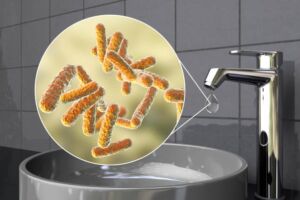
Water testing is the best way to identify all issues in your water. Well water in Nova Scotia can contain many different contaminants, minerals, and metals, depending on the geology of the area. These contaminants can cause issues that range from being simply cosmetic, to something that can damage your plumbing and pipes, to metals that can have serious long-term health effects if consumed over a long period.
Testing your well water is an essential first step in identifying and fixing these issues before they become serious. Following your test, our technicians can outline solutions that suit your unique situation. These solutions will greatly reduce or eliminate these contaminants in your water. Properly diagnosing and treating your water is important for keeping you and your home safe. Our goal is to ensure that your water is clear, safe, and delicious. In the following section, you will see some of the most common problems that we see in Nova Scotia, the effects that they can have, and how we can fix them.
Identifying Your Water Problems
Hard Water
Iron
Manganese
Hydrogen Sulphide (Sulphur)
Acidic Water
Chlorine
Salt Water
Arsenic
Uranium
Bacteria
Hard Water

One of the most common issues that we see in Nova Scotia wells, hard water is the result of a calcium or magnesium buildup that can cause white staining on pipes and fixtures over time. Another common sign of hard water is a difficulty to create soap suds when cleaning or washing dishes.
Effects
- Stains on sink or shower
- Scum in and around shower
- Low water pressure due to mineral build up
- Difficult cleaning around the house
- Dull hair or clogged pores
- Laundry feels hard and scratchy, wears out quicker
Solutions
- Water softener – The Water Shed offers various sizes of water softeners to meet the needs of you and your family.
Iron

Another very common water contaminant in Nova Scotia is the presence of iron, which is found in the soil and rocks around the province. It can be detected through testing or by its trademark reddish-orange staining of fixtures around your home. In high concentrations, it can also affect the colour, taste, and smell of your water.
Effects
- Reddish-orange staining on sinks, showers, toilets
- Stained clothing
- Reduced water pressure from clogged pipes
Solutions
- Oxidizing filter – This type of filter will oxidize the iron in your water, allowing it to be filtered out by the media within
- Water Softener – Softeners are a great tool when your water has other elements to be removed as well. It can remove small amounts of iron without the need for a second tank to filter out multiple elements.
Manganese

With prolonged consumption in high concentration, manganese can result in memory, attention and movement abilities along with other neurological conditions in both children and adults. With proper testing, we will be able to reduce this metal in your water to satisfy the maximum allowable concentration as outlined by The Guidelines for Canadian Drinking Water Quality.
Effects
- Black or brown staining of fixtures
- Metalic taste
- Long-term neurological health effects
Solutions
- Air Oxidation Filter
- Water Softener
Hydrogen Sulphide (Sulphur)

Easily identified by its characteristic ‘rotten egg’ smell, this is a dissolved sulphur gas in your water that gives it an off-putting smell and taste. Most often naturally caused by decaying organic matter, it can be found in both shallow and deep dug or drilled wells.
Effects
- Rotten egg smell
- Off-putting taste
Solutions
- Air Oxidation Filter
Acidic Water

Caused by a low pH level (below 6.5), acidic water can be detrimental to your plumbing and fixtures. With time, a low pH water will break down any metal that it touches.
Effects
- Blue-green staining on pipes and fixtures
- Corrosion on pipes and fixtures
- Metallic taste
Solutions
- pH Neutralizer
Chlorine

Not only found in drilled and dug wells, but a very common chemical used to treat municipal water supplies, chlorine will give your water an odd taste and smell. This chemical can also dry out your skin when not treated.
Effects
- Chlorine taste and smell
- Dry skin
Solutions
- Point-of-us Reverse Osmosis
- Carbon Filtration
Salt Water

Many Nova Scotia properties are located close to the ocean, especially cottages and waterfront properties. With wells so close to a salt water source, it is not uncommon for salt to seep into the well and up in your home.
Effects
- Salty Taste
- Erosion on fixtures
Solutions
- Reverse Osmosis
- Whole home
- Point-of-use
Arsenic

Another important reason for a water test is to test for arsenic in your water supply. This carcinogen cannot be seen, tasted, or smelled but can have many adverse side effects when consumed in large concentrations. It is most commonly found in the highest concentrations through Halifax country, South Shore, and the Valley, while still found throughout all areas of Nova Scotia to a lesser degree.
Effects
- Short term – nausea, diarrhea, muscle pain
- Long term – certain types of cancers
Solutions
- Arsenic Elimination System
- Whole Home Filtration System
- Reverse Osmosis
Uranium

Naturally found in soil and rocks around Nova Scotia, uranium has no noticeable taste or smell, therefore a chemical test will be required to determine the level of uranium in your water supply. Prolonged consumption of water with a higher concentration than the acceptable amount can lead to long term kidney damage.
Effects
- Long term organ damage
Solutions
- Reverse Osmosis
- Water Softener
Bacteria

There are many different types of bacteria found in Nova Scotia water systems, most notably coliform and E.coli, which are both tasteless and smelless. Almost all residential sales require these to be tested prior to the sale being completed. In the event that they are found in the water do offer solutions to remove them. Although they may not directly cause illness, they often show that the water source is vulnerable to infestations of other organisms that can cause harm.
Effects
- Potential for further bacteria/virus/parasite growth causing illness
Solutions
- UV Sterilization system